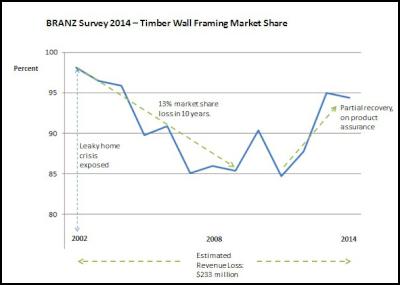Move to Re-Introduce Partially Untreated Timber Dangerous
MBIE Move to Re-Introduce Partially Untreated Timber Dangerous – Rejected By Industry
Press Release – Monday 1 May 2017
The Ministry of Business Innovation and Employment (MBIE) is secretly pushing to allow partially untreated framing timber back into the New Zealand Building Code.
The move risks reigniting the Leaky Home Crisis, estimated to have already affected up to 80,000 houses and cost New Zealand up to $30 billion.
Last year MBIE took over the timber treatment standards process and one of the changes it intends to introduce is to allow envelope treated timber. Envelope treatment involves a thin layer of treatment around the outside, but leaves the inside untreated, and at risk of decay where the timber is cut or holed, as is what happens to almost all timber.
“The leaky home crisis was New Zealand’s largest man-made disaster”, says Red Stag Group CEO Marty Verry.
“Houses are still leaking, and the public needs to have absolute assurance that the timber they are using has treatment throughout.”
Red Stag runs New Zealand’s largest sawmill with 380 staff in Rotorua, and supplies approximately twenty five percent of New Zealand’s structural timber.
“We completely reject this dangerous move by MBIE”, adds Verry. “It threatens people’s major home asset, and it risks timber’s reputation as a reliable building material.”
Figures from the latest BRANZ wall framing market share survey showed timber had 98 percent market share up to 2002, but then lost 13 percent between 2002 and 2011 - the peak of the leaky home crisis publicity. The survey shows timber’s market share increased back to 94 percent in the latest year covered by the survey - 2014. [see graphic supplied below]
“We estimate the lost market share cost the industry $233 million in sales”, says Verry. “It’s been a fragile recovery based on absolute assurance to the public that timber is treated throughout. We are not prepared to lose that trust again.”
“Any loosening of the standards takes us back the bad old days of 1995 when untreated framing timber was allowed, with the disastrous consequences that followed. Full treatment was reinstated in 2003.
“Currently the standard NZS3640 requires full sapwood penetration. Builders and consumers can trust that. The boron treatment used is harmless, yet proven over decades to be highly effective at preventing decay and insect attack. It works, so why change it?
“If New Zealand is to move to partially untreated timber, then let that be something the building industry, councils and the public are consulted on, not something pushed through behind closed doors by MBIE,” says Verry.
“Back in 1995 it was certain errant wood processors pushing untreated timber. This time it is MBIE, and the industry is resisting.
“In hindsight it is a pity more wood processors didn’t speak up in 1995. Red Stag Timber wasn’t around back then, but we’re here now. We completely reject this dangerous development.”



 NIWA: Students Representing New Zealand At The ‘Olympics Of Science Fairs’ Forging Pathway For International Recognition
NIWA: Students Representing New Zealand At The ‘Olympics Of Science Fairs’ Forging Pathway For International Recognition Coalition to End Big Dairy: Activists Protest NZ National Dairy Industry Awards Again
Coalition to End Big Dairy: Activists Protest NZ National Dairy Industry Awards Again Infoblox: Dancing With Scammers - The Telegram Tango Investigation
Infoblox: Dancing With Scammers - The Telegram Tango Investigation Consumer NZ: This Mother’s Day, Give The Gift Of Scam Protection And Digital Confidence
Consumer NZ: This Mother’s Day, Give The Gift Of Scam Protection And Digital Confidence NZ Airports Association: Airlines And Airports Back Visa Simplification
NZ Airports Association: Airlines And Airports Back Visa Simplification Netsafe: Statement From Netsafe About Proposed Social Media Ban
Netsafe: Statement From Netsafe About Proposed Social Media Ban